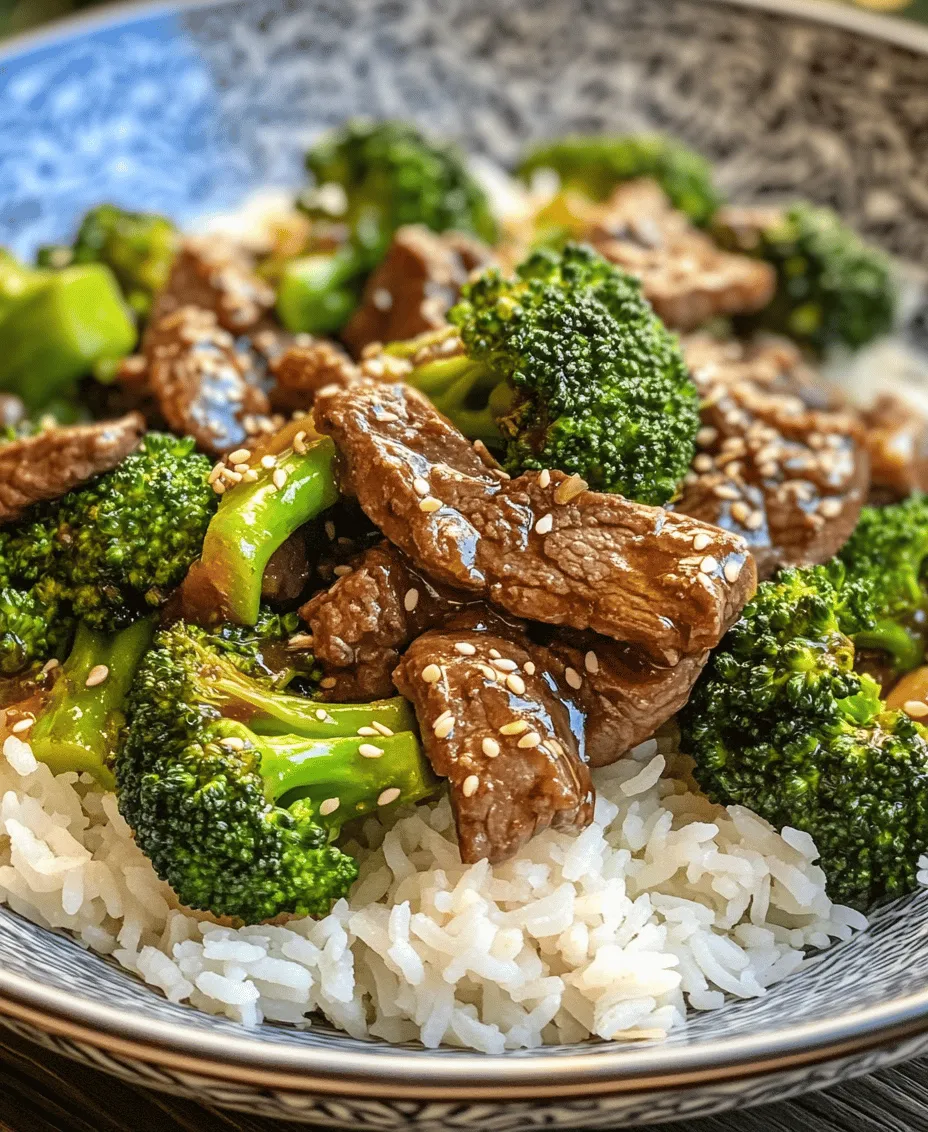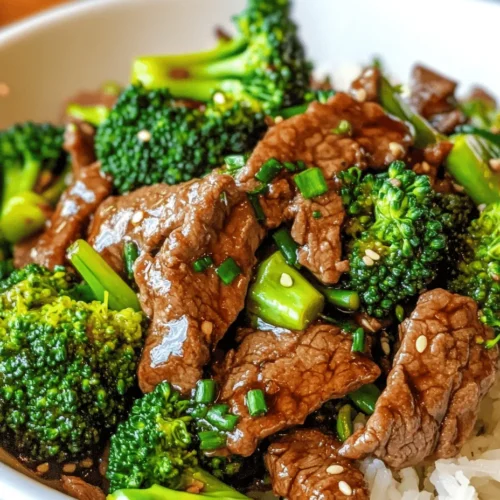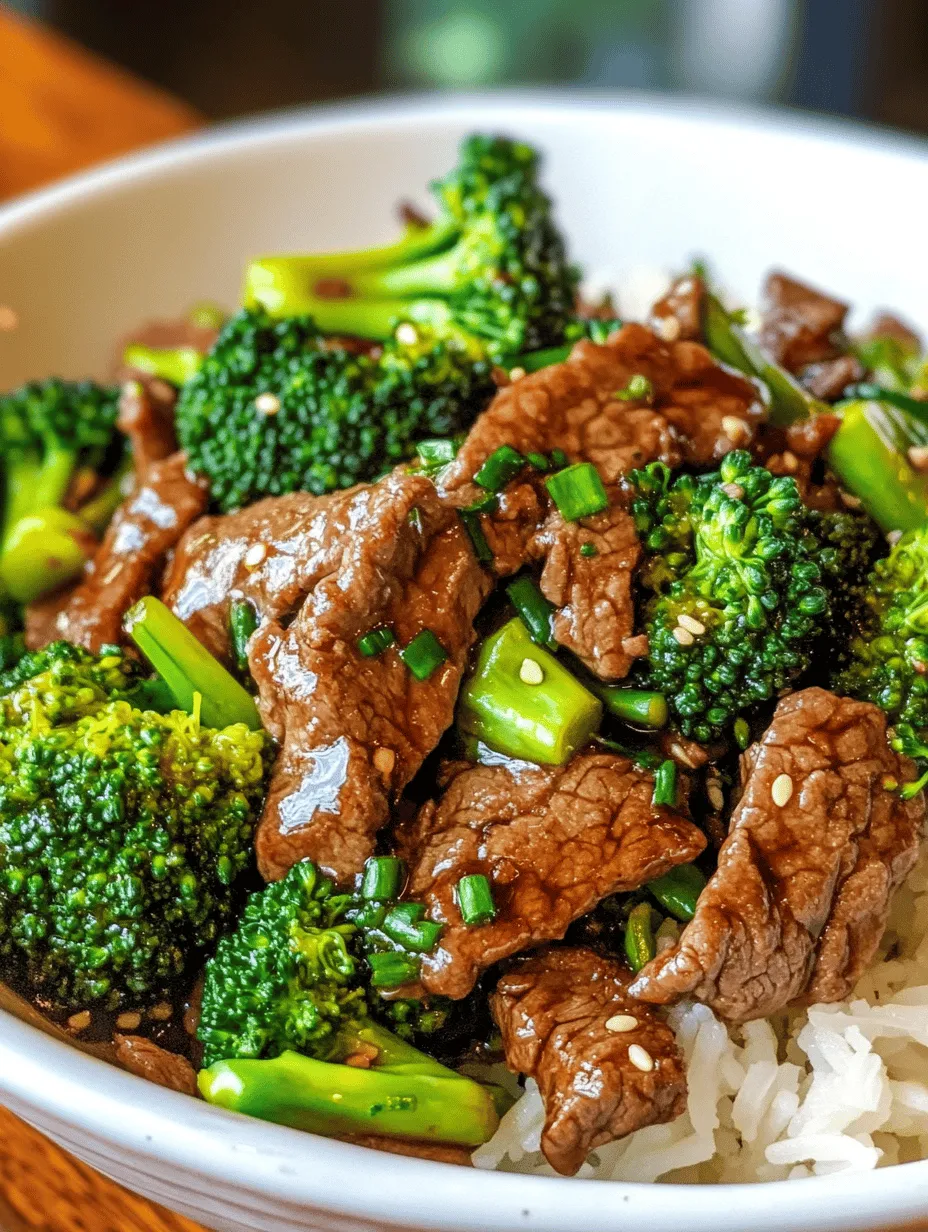Introduction
Wok-seared Chinese beef and broccoli is a beloved dish that captures the essence of Chinese cuisine. This vibrant and flavorful stir-fry features tender slices of beef and crisp broccoli florets, all enveloped in a savory sauce that brings the dish to life. Not only is it a restaurant favorite, but it’s also a dish that can be easily prepared at home, making it perfect for anyone looking to recreate authentic Chinese flavors in their kitchen.
The popularity of beef and broccoli can be attributed to its delectable taste and the balance of textures it offers. The juicy beef pairs perfectly with the crunchy broccoli, creating a harmony of flavors that is both satisfying and nutritious. In today’s fast-paced world, where busy lifestyles often lead to hasty meal choices, dishes like wok-seared beef and broccoli shine. They provide a quick, nutritious meal option that doesn’t sacrifice flavor or health.
Understanding the Ingredients
To create an authentic wok-seared beef and broccoli, understanding the ingredients is essential. Each component plays a crucial role in the dish’s overall flavor profile and texture.
Flank Steak: Ideal Cuts for Stir-Frying
When it comes to the meat component of this dish, flank steak stands out as the ideal choice for stir-frying. This cut of beef is known for its rich flavor and relatively low fat content, which makes it perfect for quick cooking methods like stir-frying. To ensure a tender texture, flank steak should be sliced thinly against the grain. Doing so breaks down the muscle fibers, resulting in a more palatable bite. Additionally, the marination process enhances the steak’s flavor and tenderness, making it a crucial step in preparing this dish.
Broccoli: Nutritional Benefits and Selection Tips
Broccoli, the vegetable star of this recipe, is not only delicious but also packed with nutrients. It is an excellent source of vitamins C, K, and A, as well as fiber and antioxidants, making it a powerhouse of health benefits. When selecting broccoli, look for vibrant green florets that are firm and tightly closed. Avoid broccoli with yellowing florets or limp stems, as these indicate that the vegetable is past its prime. Freshness is key to achieving that crisp texture that complements the beef perfectly in this stir-fry.
Soy Sauce and Oyster Sauce: Key Flavor Components
The flavor of wok-seared beef and broccoli comes primarily from its sauce, which typically includes soy sauce and oyster sauce. Soy sauce adds a umami-rich saltiness that enhances the overall depth of flavor, while oyster sauce contributes a slightly sweet and earthy note that rounds out the taste profile. Together, these sauces create a savory glaze that clings to the beef and broccoli, making every bite a burst of flavor. For an authentic experience, consider using high-quality sauces, as they can significantly elevate the dish’s taste.
Importance of Fresh Ingredients in Achieving Authentic Flavors
Using fresh ingredients is paramount when crafting this dish. Fresh vegetables not only taste better but also retain their nutrients, contributing to the overall healthiness of your meal. When everything is prepared with fresh ingredients, the final dish will be vibrant and full of life, making it an appealing choice for both the eyes and the palate.
Preparing the Beef
The preparation of the beef is one of the most critical steps in making wok-seared beef and broccoli. Proper marination and slicing techniques can greatly affect the final texture and flavor of the dish.
Discussing the Marination Process
Marinating the flank steak is essential for infusing it with flavor and ensuring it remains tender during cooking. A simple marinade often consists of soy sauce, a splash of rice wine or sherry, minced garlic, and a sprinkle of sugar. The soy sauce not only adds saltiness but also assists in breaking down the proteins in the meat, while the sugar helps to caramelize the beef during stir-frying.
Allow the beef to marinate for at least 30 minutes, although longer marination can yield even better results. Some chefs recommend marinating overnight for maximum flavor penetration. This step is what elevates the dish from ordinary to extraordinary, allowing the beef to absorb all the delicious flavors.
Importance of Marinating for Flavor and Tenderness
Marinating is not just about imparting flavor; it’s also about enhancing the tenderness of the meat. Flank steak can be a bit tough if not prepared correctly, and marination helps to mitigate this issue. The acids and enzymes in the marinade work to break down the muscle fibers, resulting in a tender piece of beef that is easy to chew and enjoy.
How Cornstarch Helps Create a Velvety Texture
Another important element in preparing the beef for stir-frying is the use of cornstarch. After marinating, the beef can be tossed lightly in cornstarch before being cooked. This technique, known as velveting, creates a protective barrier around the meat, helping to lock in moisture and resulting in a silky texture when cooked. The cornstarch creates a thin coating that prevents the meat from becoming dry or tough during the high-heat cooking process.
Tips on Slicing Flank Steak Against the Grain for Optimal Tenderness
To maximize tenderness, slicing the flank steak against the grain is crucial. The grain refers to the direction in which the muscle fibers run, and cutting against it shortens these fibers, making the meat easier to chew. For best results, let the steak rest after marinating, then use a sharp knife to slice it into thin strips, approximately 1/4 inch thick. This technique not only enhances the texture but also allows for a more even cooking process.
Blanching Broccoli: A Crucial Step
While the beef is marinating, the next step involves preparing the broccoli. Blanching is an essential part of this process and contributes to the dish’s overall appeal.
Explanation of the Blanching Process
Blanching broccoli involves briefly cooking it in boiling water and then plunging it into ice water. This technique serves multiple purposes: it brightens the color of the broccoli, helps to maintain its crispness, and reduces cooking time in the stir-fry. To blanch broccoli, start by bringing a large pot of salted water to a rolling boil. Once boiling, add the broccoli florets and cook for about 2-3 minutes, until they turn bright green and are just tender.
Why Blanching is Essential for Maintaining Color and Texture
Blanching is vital for maintaining the vibrant green color and crisp texture of the broccoli. Cooking it too long in boiling water can cause the florets to become mushy and lose their appealing color. By quickly blanching and shocking the broccoli in ice water, you halt the cooking process, preserving its freshness and crunch. This step ensures that the broccoli retains its nutrients and provides a satisfying contrast to the beef in the final dish.
How to Effectively Stop the Cooking Process with Ice Water
To stop the cooking process effectively, prepare a large bowl filled with ice water before you begin blanching. As soon as the broccoli is done cooking in the boiling water, carefully drain it and transfer it immediately to the ice water. This rapid cooling technique preserves the broccoli’s bright color and crisp texture, ensuring it remains a delightful addition to your stir-fry.
Crafting the Sauce
The sauce is the heart of wok-seared beef and broccoli, providing the rich flavor that ties all the ingredients together. Crafting the perfect sauce involves balancing the key components to achieve that authentic taste.
(continued in part 2)

Breakdown of the Sauce Ingredients and Their Flavor Profiles
When it comes to stir-frying, the sauce is what elevates a dish from ordinary to extraordinary. For our Wok-Seared Chinese Beef and Broccoli, we will be using a combination of soy sauce, oyster sauce, rice vinegar, and sesame oil. Each of these ingredients contributes distinct flavors that balance beautifully.
Soy Sauce: Salty and Umami-Rich
Soy sauce is a staple in Chinese cuisine, providing a salty flavor and rich umami essence that enhances the overall taste of the dish. It is made through the fermentation of soybeans and wheat, giving it a deep, complex flavor profile. The sodium content in soy sauce not only adds saltiness but also acts as a flavor enhancer, bringing out the natural sweetness of the beef and the crunchiness of the broccoli.
Oyster Sauce: Adds Depth and Sweetness
Oyster sauce is another crucial component that adds depth and a slight sweetness to the dish. Made from oyster extracts, this sauce is thick and dark, providing a glossy finish to the stir-fry. It complements the savory notes of the soy sauce while enhancing the beef’s natural flavors. The sweetness of oyster sauce balances the saltiness of soy sauce, making it a must-have for this recipe.
The Role of Rice Vinegar and Sesame Oil in Balancing Flavors
Rice vinegar offers a tangy brightness to the dish, cutting through the richness of the beef and the sweetness of the sauces. It also helps to tenderize the meat slightly, making it more succulent and flavorful. On the other hand, sesame oil is used sparingly due to its potent flavor. This oil adds a nutty aroma and richness that rounds out the sauce, making it more complex. Together, these ingredients create a harmonious blend that enhances the overall flavor profile of the stir-fry.
Importance of Combining Sauces Before Adding to the Stir-Fry
Before you start cooking, it’s vital to combine all the sauce ingredients in a bowl. This step ensures that the flavors meld together, allowing for an even distribution when added to the stir-fried beef and broccoli. Mixing the sauces ahead of time also saves you from scrambling at the last moment, ensuring a smoother cooking process.
Stir-Frying Techniques
Ideal Cooking Equipment: Benefits of Using a Wok
When it comes to stir-frying, a wok is your best friend. Its unique shape allows for high heat cooking and efficient tossing of ingredients. The sloped sides facilitate even cooking and provide ample space for stirring without spilling. If you don’t have a wok, a large skillet can suffice, but you may not achieve the same level of searing and quick cooking. Opting for a well-seasoned or non-stick wok will also help prevent the beef from sticking, ensuring a perfect sear.
High Heat Cooking: Importance for Achieving a Good Sear
Stir-frying is all about high heat. The goal is to cook the ingredients quickly, allowing them to retain their freshness and crunch. Preheat your wok until it’s smoking hot before adding oil. This high temperature will help achieve that coveted sear on the beef, locking in moisture and flavor. Remember, if the pan isn’t hot enough, the ingredients will steam instead of sear, resulting in a less desirable texture.
Step-by-Step Guide on Stir-Frying the Beef for Perfect Doneness
1. Prepare the Beef: Slice the beef against the grain into thin strips. This helps break down the muscle fibers, making the meat more tender.
2. Marinate: For additional flavor, you may choose to marinate the beef in a mixture of soy sauce, cornstarch, and a dash of rice vinegar for about 15-30 minutes before cooking.
3. Add Oil: Once the wok is hot, pour in a tablespoon of vegetable oil. Swirl it around to coat the surface evenly.
4. Sear the Beef: Add the beef strips in a single layer, making sure not to overcrowd the wok. Allow them to sear undisturbed for 1-2 minutes before stirring. This helps to develop a nice crust.
5. Check Doneness: Cook the beef for about 3-5 minutes total, depending on the thickness of your slices. You want it to be browned on the outside and slightly pink in the center.
How to Sauté Aromatics for Maximum Flavor Infusion
After the beef is cooked, remove it from the wok and set it aside. Add a bit more oil if necessary, and then toss in minced garlic and ginger. Sauté these aromatics for about 30 seconds until fragrant, being careful not to burn them. This step is key to infusing the oil with flavor, which will then carry through the entire dish.
Bringing It All Together
Combining Beef, Broccoli, and Sauce: Techniques for Even Distribution
Once the aromatics are ready, return the beef to the wok along with the prepped broccoli. Quickly add the sauce mixture, stirring to coat everything evenly. The goal here is to ensure that each piece of beef and broccoli is coated in the flavorful sauce. Use a spatula or wooden spoon to toss the ingredients gently but thoroughly.
Adjusting Cooking Time for Desired Sauce Thickness
At this stage, you can adjust the cooking time based on your preference for sauce thickness. If you like a more substantial sauce, allow it to simmer for an additional minute or two until it thickens slightly. For a thinner sauce, simply toss and serve immediately. Keep an eye on the color and consistency; you want it to be glossy and cling to the ingredients without being overly thick.
Visual Cues for Knowing When the Dish is Ready
The dish is ready when the broccoli is vibrant green and tender-crisp, while the beef is heated through. The sauce should cling to the ingredients but not be overly runny. A quick taste test can also help you gauge if any additional seasoning is needed.
Serving Suggestions
Options for Serving: Rice vs. Noodles
Wok-Seared Chinese Beef and Broccoli can be served over steamed white rice, brown rice, or even noodles. Rice provides a neutral base that absorbs the sauce beautifully, while noodles add a delightful chewiness. Both options are excellent choices, depending on your preference.
Presentation Tips for a Visually Appealing Dish
To make your dish visually appealing, consider garnishing with sliced green onions or a sprinkle of sesame seeds just before serving. A colorful plate creates an inviting presentation that is sure to impress your family and friends. Additionally, using a shallow bowl or plate can help showcase the vibrant colors of the beef and broccoli.
Nutritional Balance of the Meal and Its Suitability for Various Dietary Preferences
This dish is not only delicious but also nutritionally balanced, offering protein from the beef, fiber from the broccoli, and carbohydrates from rice or noodles. For a healthier twist, consider using lean cuts of beef or substituting the beef with tofu for a vegetarian option. This versatility makes it suitable for various dietary preferences, including gluten-free options by using tamari instead of regular soy sauce.
Conclusion
Wok-Seared Chinese Beef and Broccoli is a simple yet flavorful dish that brings the essence of Chinese cuisine right to your home kitchen. With tender beef, crisp broccoli, and a savory sauce, this recipe is perfect for a quick weeknight meal or a special gathering. The ease of preparation, combined with the delightful balance of flavors, encourages everyone to give this recipe a try.
Cooking is a joy, and sharing meals with loved ones can create cherished memories. So roll up your sleeves, gather your ingredients, and embark on this culinary adventure. You’ll find that making delicious meals at home is not only rewarding but also a wonderful way to connect with family and friends over a shared love for food. Enjoy the process, and happy cooking!



